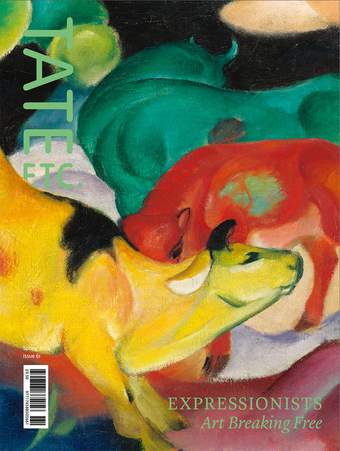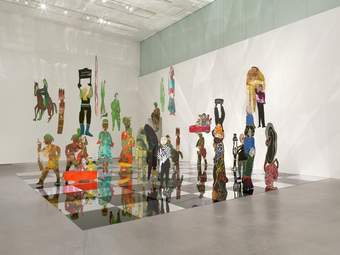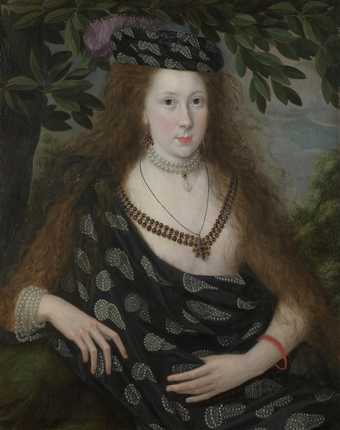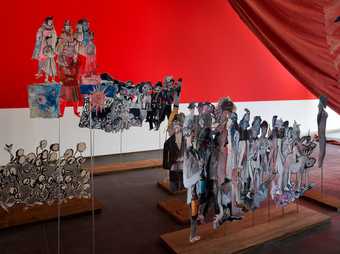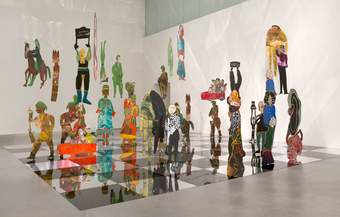
Anna Boghiguian
Institution vs. The Mass 2019
© Anna Boghiguian. Photo © Tate (Sam Day)
I get lost trying to find Anna Boghiguian. It’s a hazy afternoon in Cairo. Her studio overlooks the Nile and I can imagine her peering down at my solitary figure darting through the relentless flow of cars and tuk-tuks. Passing by the arches of Magra El-Oyoun, a Mamluk-era aqueduct, I abandon Google Maps for the dependability of fading street signs. The Nile is a centrality. I keep to its left shoulder, turning a corner and walking onwards. It’s not lost on me that my own wanderings reflect Boghiguian’s own fascination with the voyage as an integral part of the artistic process. To meander is to be led by one’s curiosities. The detours become just as important as the destination.
Boghiguian, a distinguished Cairo-born artist, has been making art professionally since the 1970s. Before that, as she tells me when I eventually reach her eighth-floor studio, she was interested in journeying and tarrying. She embodies a languid, informal cosmopolitanism, a spirit that can be detected in her subjects, influences and travels. Her interests are a patchwork of affinities – threads she tugs at to breathe life into collective, persistent histories. History is weighted with ambivalence, and Boghiguian is drawn to heightened states of incertitude. Institution vs. The Mass 2019, her large-scale installation currently on show at Tate Modern, reflects such tensions, depicting the relationships between people and power. These conflicting interests and dynamics she likens to torrents raging beneath a river’s surface.
Institution vs. The Mass stages these conflicts on a checkerboard floor. Boghiguian creates a world out of a chess set, her 32 cut-out figures positioned on mirrored tiles, vivid with colour and symbolism. Divisions are drawn. The ‘Institution’ is represented by helmeted soldiers brandishing rifles, circling horsemen, and the blank gaze of a king and his queen. On the other side of the divide, the roiling ‘Mass’ dominates, its ranks filled with impassioned demonstrators: cars loaded with people, placards, protest banners, raised hands and fists. It’s not simply a question of competing throngs. The work asserts the interdependence of our fates, regardless of our positions on the chessboard. A wash of text on the wall likens chess to poetry, where ‘different verses flow with different games and movements.’
Boghiguian situates herself within the crowd. ‘The Mass has to be taken care of ’, her text reads. The Mass is a flood of chaotic intimacy. Between the despots and the disenfranchised, her cut-out figures become a recognisable procession of characters, activated and repressed within the circuitous game in which they are forced to participate. When I speak to Boghiguian about the parameters of contemporary democracy, she is assuredly contemplative.
‘What is very traumatic is that we are very conscious of our ethnic identities and our ethnic boundaries’, she reflects. To her, this consciousness fixes us in place, stifling our imaginative capacities. Our political horizons are similarly choked. Boghiguian has little interest in the overdetermined.
"To meander is to be led by one's curiosities. The detours become just as important as the destination."
Chess itself is a game of indeterminate origins. Boghiguian’s accompanying text traces its winding journey across India, China, Persia and Europe – a history marked by trade, exchange and conquest. Institution vs. The Mass uses chess as a connective glue, drawing onlookers into the game as ‘strategy, cosmology, logic, and music’. There, again, between the murkiness of the game’s beginnings and the constancy of the pieces, is Boghiguian’s insistence on the contradictory. The field of inquiry – and possibility – is kept wide open. When considering her path as an artist, Boghiguian never wanted to be pushed in any direction, the result being a lifetime spent resisting moulds.
‘I wanted to develop as I wanted to develop, not as someone else wanted me to develop’, she explains. Now in the twilight of her seventies, this has proven to be an inspired decision. Boghiguian is animated by the work ahead of her and is busy with new drawings, paintings, projects, and future exhibitions, all while making plans for her archive.
A painting class that Boghiguian took in the early 1970s introduced her to the encaustic technique, an ancient process using beeswax and pigment. In their layered vibrancy, the cut-outs featured in the Institution vs. The Mass reveal her long-standing attachment to this technique. Invented by the Greeks and preserved in the Fayum mummy portraits from Roman-era Egypt, Boghiguian is admittedly drawn to encaustic painting’s associations with death and immortality. What she identifies as the ‘concept of permanence and impermanence’ is played out in melted wax and sheer physicality.
The city will always pursue you. The famed 20th-century Greek poet and life-long Alexandrian C.P. Cavafy knew this, his voluptuous poems spilling forth from this truth. Boghiguian began illustrating Cavafy’s poetry in 1980 and has been in conversation with his work ever since. The city may overwhelm, but it isn’t an enclosure. It can be a lighthouse of the mind, a window from which to look outwards. From her drawings of mutable Cairo to the coastal reveries captured by Cavafy, Boghiguian’s work is infused with this sensibility. All cities retain an element of the unconquerable. For their inhabitants, whom they attract and sometimes trap, they are fertile breeding grounds for transformation. Boghiguian tells me that she used to stroll leisurely through foreign cities for miles. Walking became her way of opening unknown doors. Now she takes taxis, moving at a different pace.
From her rooftop I can see her hometown stretched out before me, its refracted histories always a stumble away. This isn’t just her Cairo but the Cairo that welcomed outsiders like the poet-philosopher Rabindranath Tagore, whose works she has also illustrated. We talk about Tagore, her drawings of the Ganges, and the influence of the Italian modernist poet Giuseppe Ungaretti. A translucent humanism shines through these cross-pollinations. Delimitations are eroded. I get the sense that, even in works like Institution vs. The Mass, a blurring of boundaries prevails. Boghiguian is an artist of breathing, heaving interconnectedness, the kind that lives beyond the realm of theory or the sloganeering of the political, digging its talons into the craggy face of the everyday. It’s oppositional, but never opposed.
Institution vs. The Mass was purchased with funds provided by Tate Members and Tate International Council in 2020 and is on display in Materials and Objects, Tate Modern.
Momtaza Mehri is a poet and essayist who lives in London. Her book Bad Diaspora Poems won the Forward Prize for Best First Collection.

